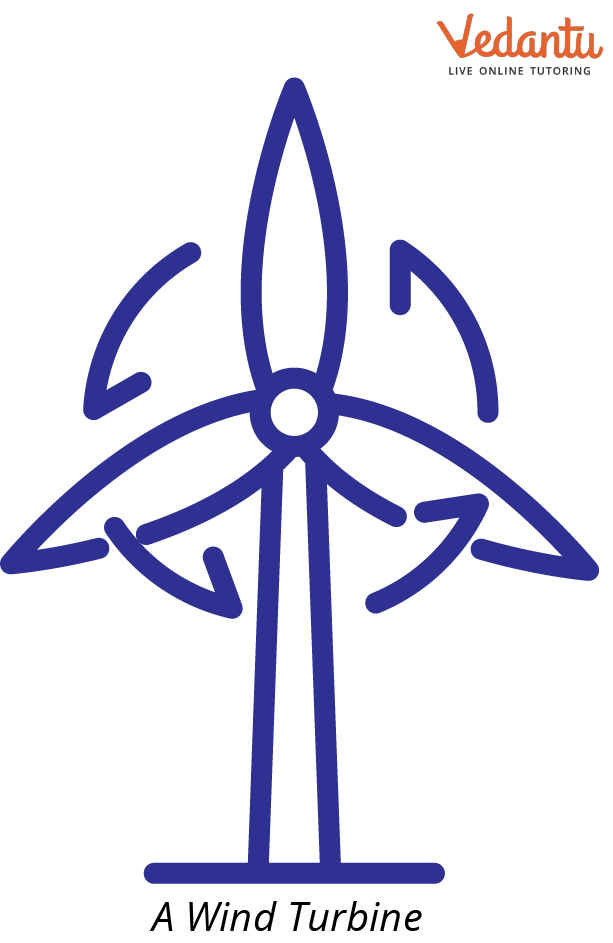




How Do Wind Turbines Work? Key Principles Explained
A wind turbine might have up to 8,000 unique parts. The usual height of a wind turbine tower is 300 feet, roughly the height of the Statue of Liberty. Wind turbine blades are typically 200 feet long. One of the world's most rapidly expanding energy sources is wind energy. Wind turbines transform the kinetic energy of the wind into mechanical energy.
The biggest turbines can generate enough electricity to run 600 houses. Hundreds of these turbines are put in lines in windy locations, such as a ridge, to construct wind farms. For some reason, people have criticised wind farms. Wind turbines are claimed to make noise and annoy surrounding neighbours. Also said to be affecting bat and bird populations.

A Wind Turbine
What is Wind Energy?
Wind energy is the energy available to the wind due to its motion. Wind turbine converts mechanical energy from the wind into electrical energy using generators. Wind energy is used to generate electricity by utilising kinetic energy provided by moving air. Wind energy is power generated by the wind's force. Over the next ten years, the wind energy market is expected to continue expanding. The majority of it is currently taking place in the US and Europe, but China and India are growing rapidly. These are the following applications of the wind energy:
A clean and renewable energy source is wind energy. Windmills use the mechanical energy of the wind to turn a generator and produce electricity. People are using wind energy to generate power for their homes as it is environmentally friendly.
Wind energy is cheap. One of the most affordable energy sources currently accessible is generated by utility-scale, land-based wind turbines. Additionally, as wind energy research and technology improve, its cost-competitiveness continues to rise.
Wind energy generation works effectively in functioning landscapes with many uses, including agriculture. Wind energy is easy to adopt in rural or isolated places, such as farms and ranches or coastal and island villages, where high-quality wind resources are frequently found.
How are Winds Formed?
The wind is airflow that is moving. The wind is created when the sun heats the atmosphere differently in different parts. As a result, warmer air expands and exerts less pressure when it is warmer than cooler. Cooler air particles, often more closely packed together, will drop into those low-pressure locations as the warmer air rises. The wind is created by the movement of air particles, which are moved by heating and cooling areas.
The air molecules hit the things and cause them to move, which is how wind causes objects to move. The wind is the constant movement of air from high to low pressure.

Wind Blowing
Conclusion
Wind power is a clean, renewable energy source. It has huge potential to meet a nation's energy needs and positive energy balance. The advantages of wind energy for the environment are highlighted compared to older technologies. Wind generates power without consuming fuel or polluting the environment. The primary source of renewable energy is wind.
FAQs on Essential Facts About Wind Turbines
1. What is a wind turbine and what is its main purpose?
A wind turbine is a tall machine with large blades that looks like a giant fan. Its main purpose is to capture the power of the wind's kinetic energy and convert it into electricity. This makes it a key technology for producing clean and renewable energy.
2. How does a wind turbine generate electricity from wind?
A wind turbine generates electricity in a few simple steps. First, the wind blows against the large blades, causing them to spin. These blades are connected to a drive shaft that turns a generator inside the turbine. As the generator spins, it produces electricity, which is then sent through cables to power our homes, schools, and cities.
3. What is the original source of the energy that makes wind blow?
The primary source of all wind energy is the Sun. The Sun heats the Earth's atmosphere and surface unevenly. This creates differences in air pressure and temperature, causing air to move from high-pressure (cooler) areas to low-pressure (warmer) areas. This movement of air is what we call wind.
4. Are the blades of all wind turbines the same size?
No, the blades of wind turbines vary greatly in size depending on their intended use. Here are some examples:
- Small turbines may have blades less than 200 feet long and are suitable for powering a single home or a small farm.
- Large utility-scale turbines, like those in wind farms, can have blades well over 300 feet long to capture more wind and generate electricity for thousands of homes.
5. Which country is the world leader in producing wind energy?
China is the world's largest producer of wind energy. It has more wind power capacity than any other country, with massive onshore and offshore wind farms contributing significantly to the global supply of renewable energy.
6. Why do most modern wind turbines have only three blades instead of more?
Most wind turbines have three blades because it offers the perfect balance between efficiency, stability, and cost. While having more blades might seem like it would capture more wind, it also increases air resistance (drag) and construction costs. Conversely, one or two blades can create an unstable wobble. Three blades provide a smooth, stable rotation to generate power effectively without putting excessive stress on the turbine's structure.
7. What is the difference between an onshore and an offshore wind turbine?
The main difference between these two types of turbines is their location and the advantages that come with it.
- Onshore wind turbines are located on land, often grouped together in windy areas like hillsides or open fields.
- Offshore wind turbines are built in bodies of water, like oceans or large lakes. They can be much larger and capture stronger, more consistent winds, which allows them to generate significantly more electricity than their onshore counterparts.
8. What happens to a wind turbine if the wind becomes too strong?
For safety, wind turbines are designed to automatically shut down when winds become too strong. This is a critical safety feature to prevent damage. If wind speeds exceed a safe limit (typically around 55 mph), a braking system is activated, and the blades are 'feathered'—turned to an angle that stops them from catching the wind and spinning.
9. Why are wind turbines built to be so tall?
Wind turbines are built to be very tall to reach higher altitudes where the wind is stronger and more consistent. Near the ground, wind is often slowed down or made turbulent by obstacles like trees, hills, and buildings. By placing the blades high up, the turbine can access the more powerful, smoother airflows, allowing it to generate electricity much more efficiently and reliably.
10. Who was the first person to invent a wind turbine for making electricity?
The first automatic wind turbine designed to generate electricity was built by an American inventor named Charles F. Brush in 1887. He constructed it in Cleveland, Ohio, and it was used to power his mansion with about 12 kilowatts of electricity, marking a historic step in the development of renewable energy technology.









